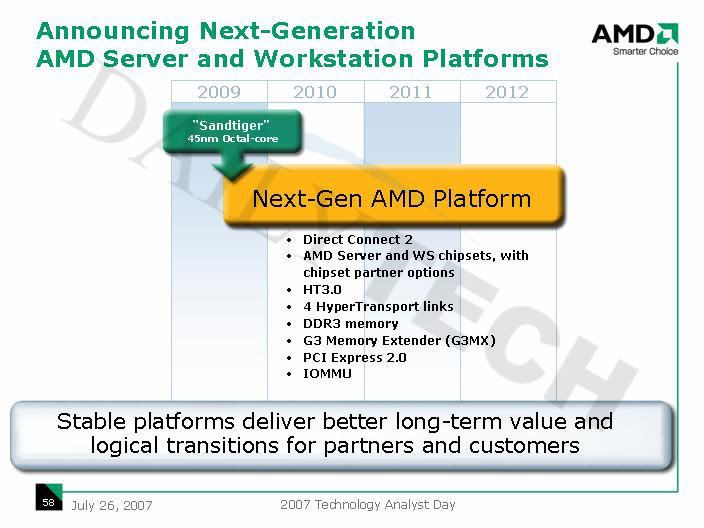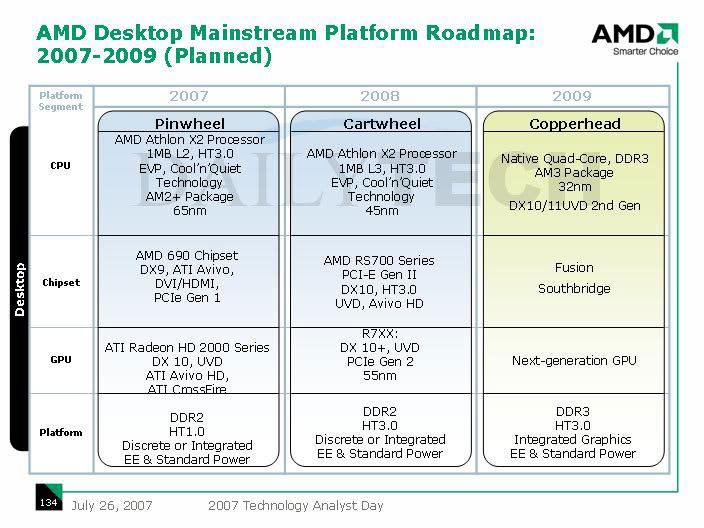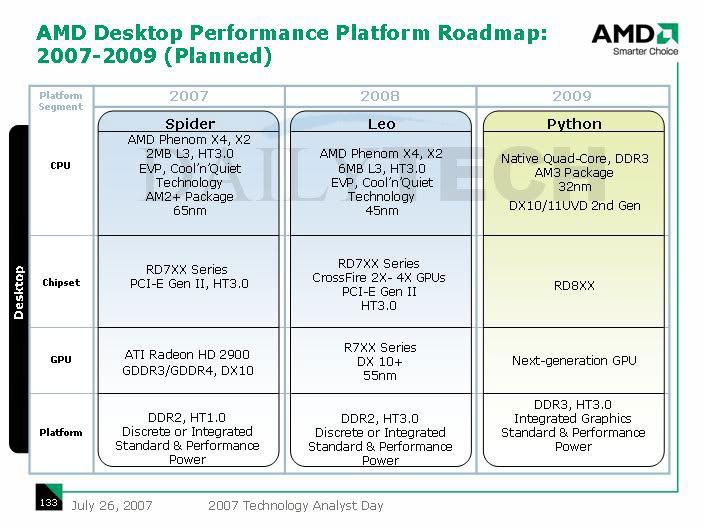AMD: Still In The Game
http://www.anandtech.com/cpuchipsets/showdoc.aspx?i=3050&p=1
AMD Talks Octal-Core Opterons
http://www.dailytech.com/AMD+Talks+OctalCore+Opterons/article8200.htm

AMD Previews New Desktop Platforms and Fusion
http://www.dailytech.com/article.aspx?newsid=8202


http://www.anandtech.com/cpuchipsets/showdoc.aspx?i=3050&p=1
AMD Talks Octal-Core Opterons
http://www.dailytech.com/AMD+Talks+OctalCore+Opterons/article8200.htm

New eight-core "Sandtiger" set for 2009 on third-generation Opteron platform
AMD previewed its third-generation Opteron platform during the company’s Technology Analyst. The third-generation AMD Opteron platform is set for a 2009 debut with a new Sandtiger-core processor. AMD’s current Socket 1207 platform is the Opteron’s second-generation platform and designed to accommodate Opteron revision F, Barcelona and the 45nm die-shrink Shanghai processors.
Sandtiger ups the core ante with eight-cores. AMD will manufacture the octal-core Sandtiger on a 45nm fabrication process. Sandtiger introduces HyperTransport 3.0, or HT3, to AMD’s server and workstation platforms. The processor will have four HyperTransport links with a new Direct Connect 2 infrastructure.
Sandtiger will also support DDR3 memory. The third-generation AMD Opteron platform will be the first platform to support G3 Memory Extender, or G3MX, technology for larger memory capacities. The platform also supports PCI Express 2.0.
New server and workstation chipsets will accommodate the new platform. AMD makes no mention on socket compatibility of the third-generation Opteron platform, but AMD’s track record shows socket changes with a new platform.
Before Sandtiger, AMD has Shanghai up its sleeves. Shanghai will be the 45nm shrink of Barcelona. AMD has Shanghai on the roadmap for a 2008 launch to replace Barcelona. Shanghai will drop into existing second-generation AMD Opteron platforms.
Shanghai features minor improvements such as a 6MB L3 cache and IPC improvements. The core will continue to have 512KB of L2 cache per core with three HT1 links. Registered DDR2 memory continues to be the memory of choice for Shanghai.
Expect AMD to unveil its third-generation AMD Opteron platform with G3MX technology and Sandtiger core in 2009 and Shanghai around the second half of 2008.
AMD Previews New Desktop Platforms and Fusion
http://www.dailytech.com/article.aspx?newsid=8202


New standard desktop platforms in 2008 and Fusion platforms for 2009 with a slight mention of next-generation Radeon
AMD today previewed its next two generation of desktop platforms for performance and mainstream platforms. The new platforms outline details of new AMD chipsets, processors and graphics cores.
AMD’s next new performance platform will be Spider. Spider is the first platform for AMD Phenom X4 and X2 processors, slated for later this year. AMD pairs the Phenom X4 and X2 processors with the upcoming RD7xx series chipsets for Spider. Spider also features PCIe 2.0, and HyperTransport 3.0, or HT3.
Following Spider is Leo. Leo is AMD’s 2008 platform refresh, again designed to accommodate Phenom X4 and X2 processors. Leo will accommodate the upcoming 45nm refresh of the Phenom X4 and X2. The refreshed Phenom processors will feature 6MB of L3 cache on top of the standard die shrink. Leo will still use the RD7xx series chipsets, but with support for up to four GPUs in CrossFire. AMD plans to initially debut quad-CrossFire with its FASN8 4x4 platform.
AMD’s Leo platform preview also mentions light details of its next-generation GPU. The next-generation R7xx series GPU will be DirectX 10+ compliant. AMD plans to manufacturer R7xx on a 55nm fabrication process as well.
Moving into 2009 is the introduction of Python, a Fusion based platform. Python features a native quad-core Fusion processor in an AM3 package. The Fusion processor will feature a DirectX 10 or 11 compliant graphics core with a second-generation Universal Video Decoder, or UVD. AMD plans to manufacturer this variant of Fusion on a 32nm fabrication process. The Fusion-based processor will also pair an RD8xx series chipset and support DDR3 memory.
AMD’s next-generation Cartwheel mainstream platform is set to replace the current Pinwheel platform. Pinwheel consists of an Athlon X2 processor with the AMD 690 chipset. Cartwheel will accommodate upcoming 45nm Athlon X2 processors with a new chipset. The new RS700 series chipset will deliver PCIe 2.0 and HT3.0 support. A new integrated graphics core delivers DirectX 10 compliant graphics with UVD and Avivo HD video processing technologies.
AMD plans to position Fusion for mainstream platforms as well. AMD’s Copperhead platform features a native quad-core Fusion processor similar to the Fusion in Python. AMD is light on Copperhead’s chipset details, but mentions the platform will have a Fusion south bridge. The platform will also support DDR3 memory.
Expect AMD to debut Leo and Cartwheel next year with its 45nm die-shrinks and the Fusion-based Python and Copperhead platforms in 2009.



 - I've forever been waiting for AMD to get something worthwhile, didn't fancy taking the Intel plunge just yet but i'll have to at this rate lol
- I've forever been waiting for AMD to get something worthwhile, didn't fancy taking the Intel plunge just yet but i'll have to at this rate lol